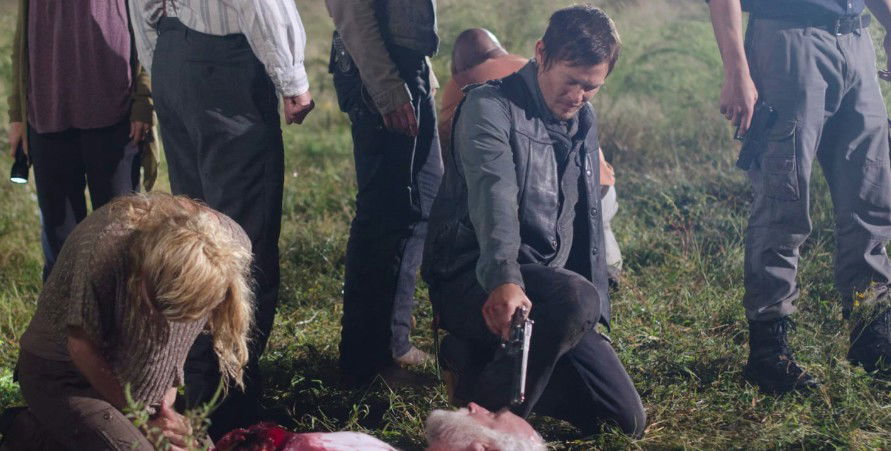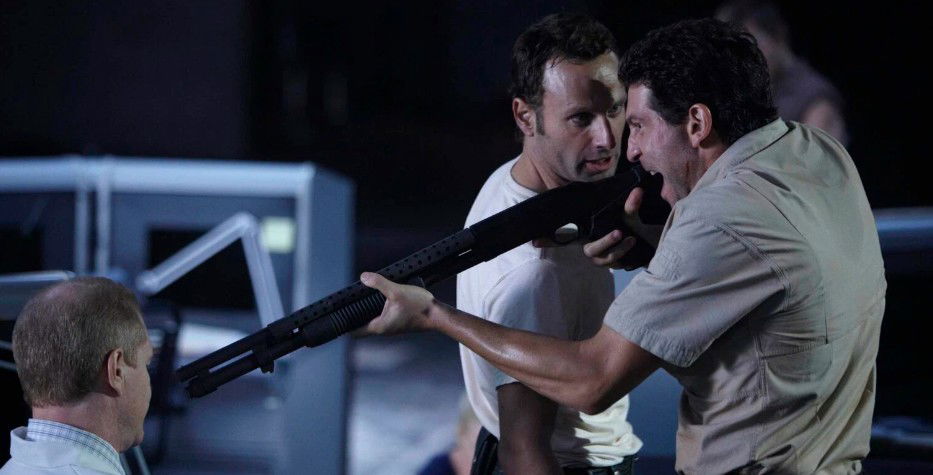The Walking Dead’s Most Gruesome Moment: A Shocking Scene Marred by a Surprising Flaw
The Walking Dead, AMC’s post-apocalyptic juggernaut, is no stranger to shocking its audience with visceral violence, but one moment stands above the rest as the most gruesome in its 11-season run: the Season 7 premiere deaths of Glenn Rhee and Abraham Ford at the hands of Negan’s barbed-wire bat, Lucille. Described by fans and critics as a turning point for the series, this scene left viewers reeling with its unrelenting brutality. However, a surprising flaw in its execution has sparked debate, with some arguing it undermined the moment’s impact. Let’s unpack this infamous scene, explore the flaw that caught fans off guard, and examine why it remains a lightning rod for discussion nearly a decade later.

The Scene That Broke Fans’ Hearts
The Season 7 premiere, “The Day Will Come When You Won’t Be,” aired on October 23, 2016, resolving the infamous Season 6 cliffhanger where Negan, played by Jeffrey Dean Morgan, prepared to kill one of Rick Grimes’ group with his signature weapon, Lucille. After months of speculation, the episode revealed not one but two victims: Abraham Ford (Michael Cudlitz), the tough-talking ex-soldier, and Glenn Rhee (Steven Yeun), the beloved everyman who’d been with the show since Season 1. The scene, adapted from Robert Kirkman’s comic issue #100, is a masterclass in tension and horror, with Negan’s taunting monologue and the group’s despair setting the stage for a double execution.
Abraham is killed first, his head bashed in after defiantly staring Negan down, his final words a bold “Suck my nuts.” The group, already shattered, is then blindsided when Negan turns on Glenn, provoked by Daryl’s impulsive punch. Glenn’s death is particularly harrowing: Lucille’s blows leave him barely alive, his eye bulging and skull fractured, as he gasps, “Maggie, I’ll find you,” to his pregnant wife before succumbing. The graphic violence—blood, brain matter, and Glenn’s disfigured face—was a deliberate choice by showrunner Scott Gimple and director Greg Nicotero to mirror the comic’s brutality, ensuring fans felt the weight of Negan’s dominance over Rick’s group.
The scene’s impact was immediate and seismic. Viewership for the premiere hit 17 million, but the backlash was swift, with fans and critics decrying the “torture porn” level of gore. Social media erupted, with posts lamenting the loss of Glenn, a fan favorite whose comic death many hoped the show would avoid. The double killing led to a significant drop-off, with 6 million fewer viewers tuning in a month later, and prominent figures like Joe Rogan quitting the show, calling the deaths “disrespectful” to the audience’s emotional investment. Even cast members, like Chad Coleman (Tyreese), admitted to stopping watching, while Cudlitz later acknowledged the dual deaths were “too much of a loss” for fans.
The Hidden Flaw: A Narrative Misstep
Amid the outcry over the scene’s violence, a less obvious flaw emerged that has fueled ongoing debate: the decision to kill two characters instead of one, diluting the emotional weight of Glenn’s death. In Kirkman’s comic, Negan kills only Glenn, a pivotal moment that establishes his villainy and devastates the group. The show’s choice to add Abraham’s death, while shocking, arguably undermined Glenn’s moment by splitting the audience’s grief and overwhelming viewers with trauma. This narrative misstep, described by some as a “bait-and-switch,” left fans feeling manipulated rather than moved.
The flaw stems from the Season 6 cliffhanger, where Negan’s victim was left ambiguous, building anticipation but also setting unrealistic expectations. By killing Abraham first, the show tricked viewers into thinking Glenn might be spared, only to deliver his death minutes later. This double blow felt excessive to many, as it robbed Glenn’s death of the singular focus it deserved. Glenn, a character who’d grown from a pizza delivery boy to a moral anchor, was central to the group’s hope, especially with Maggie pregnant. His comic-accurate death was meant to be a gut-punch, but Abraham’s killing—a character less integral but still beloved—diluted the spotlight, making the scene feel like shock for shock’s sake.
Fan discussions online highlight this issue. Users argue that Abraham’s death, while impactful, overshadowed Glenn’s, with some suggesting it was added to subvert comic readers’ expectations. Others contend that a single death would have been more faithful to the source material and emotionally resonant, allowing viewers to process Glenn’s loss fully. Critics have echoed this, noting that the scene’s pacing—dragging out Negan’s taunts before delivering two killings—felt manipulative, prioritizing spectacle over storytelling.
The show’s creators have defended the decision. Gimple argued that Abraham’s death established Negan’s unpredictability, while Glenn’s reinforced his cruelty, setting up Rick’s submission. Nicotero emphasized the need to match the comic’s intensity, using practical effects to ensure authenticity. Yet, even Cudlitz, who played Abraham, later admitted the double death was a gamble that cost the show viewers, suggesting a single killing might have preserved audience goodwill.
Why the Scene Still Haunts Fans
Despite its flaw, the Season 7 premiere remains The Walking Dead’s most gruesome and debated moment because it encapsulates the show’s high-stakes storytelling. The scene’s brutality wasn’t just about gore; it was a narrative pivot, stripping Rick’s group of hope and introducing Negan as a formidable antagonist. Jeffrey Dean Morgan’s charismatic performance, blending menace with dark humor, made Negan an instant icon, while the deaths underscored the show’s theme of survival at any cost. For many, the scene’s raw power—Glenn’s final words, Maggie’s anguish, Rick’s brokenness—outweighs its missteps, cementing it as a defining moment.
The scene also reflects The Walking Dead’s willingness to take risks, a hallmark that kept it relevant for 11 seasons. By staying faithful to the comic’s violence, the show honored its source material, even if it alienated some viewers. The decision to kill Glenn, a character fans hoped would survive due to his growth and impending fatherhood, was a bold statement that no one was safe, reinforcing the apocalypse’s unpredictability. This approach, while controversial, sparked intense fan engagement, with online forums buzzing with reactions ranging from heartbreak to admiration for the show’s audacity.
The franchise’s evolution since 2016 has also kept the scene in the conversation. Spinoffs like Dead City, Daryl Dixon, and The Ones Who Live have shifted focus to character-driven stories, addressing criticisms of the main series’ later seasons. Dead City, for instance, explores Negan’s redemption, giving new context to his Season 7 actions, while Daryl Dixon shows Daryl grappling with his past, including the trauma of Glenn’s death. These spinoffs, available on AMC+ and Netflix, keep the Walking Dead universe alive, with Daryl Dixon Season 3 in production and crossovers planned, ensuring the franchise’s relevance.

The Flaw’s Lasting Impact
The flaw in the Season 7 premiere—doubling down on deaths—had tangible consequences. The viewership decline, from 17 million to under 3 million by the 2022 finale, suggests the scene alienated a significant portion of the audience. Fans like Joe Rogan, who called the deaths “non-valiant,” represent a broader sentiment that the show prioritized shock over emotional payoff. The backlash also shaped the franchise’s trajectory, with later seasons and spinoffs scaling back on graphic violence to focus on redemption, hope, and new settings like France in Daryl Dixon.
Yet, the scene’s flaw doesn’t erase its cultural impact. It remains a benchmark for TV violence, often compared to Game of Thrones’ Red Wedding for its emotional devastation. Fans continue to debate its execution, with some defending the double death for its realism—Negan’s comic persona thrives on excess—while others see it as a missed opportunity to let Glenn’s loss stand alone. The scene’s legacy is evident in the franchise’s resilience, with spinoffs drawing strong streaming numbers and keeping characters like Negan and Daryl in the spotlight.
Why the Debate Persists
The Season 7 premiere’s gruesome moment resonates because it encapsulates The Walking Dead’s strengths and flaws: fearless storytelling, complex characters, and occasional overreach. The flaw—killing two characters instead of one—sparked a reckoning, forcing the show to evolve to regain viewer trust. Its impact lingers in fan discussions, with many revisiting the episode to parse its emotional and narrative choices. The scene’s brutality, while divisive, underscores the franchise’s commitment to reflecting the apocalypse’s harshness, making it a touchstone for debates about violence in media.
For fans, the moment is a wound that never fully heals, tied to the loss of Glenn, a character who embodied hope. For critics, it’s a cautionary tale about balancing fidelity to source material with audience expectations. As the Walking Dead universe expands, with spinoffs exploring new stories and redemption arcs, the Season 7 premiere remains a pivotal chapter, flawed but unforgettable. Whether you view it as a misstep or a masterstroke, it’s a moment that continues to define The Walking Dead—and why fans can’t stop talking about it.





